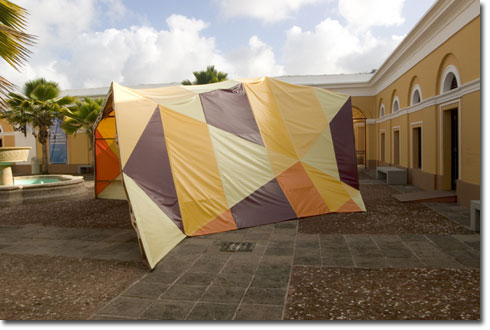Trienal Poli/Gráfica de San Juan,
Oct 01, 2004 - Dec 01, 2004
San Juan, Puerto Rico
Poetic Odyssey at the San Juan Triennial 2004
by Elvis Fuentes
Marginal route: Not Registered
Other readings and infinite routes can be traced successively from Silveira’s graphic facade, our initial starting point. For example, some "marginal" or "Fuera de registro" streets, an axis coming from the word "register" associated with printmaking workshops and also with the legal term "un/documented". For example, techniques of mechanical reproduction in the Libro de Velázquez - a master out of focus - by Waltercio Caldas (Brazil); or a renewal of the traditional such as the pyrography utilized by Oscar Muñoz (Colombia), self-portraits made from cigarette burns; the calligraphic cuts of Marco Maggi (Uruguay) bringing painterly protagonism to paper; the "disproportionate" weaves with architectural motifs by Ana Rosa Rivera (Puerto Rico); or the bomber-hunter kites that Miguel Luciano (Puerto Rico) flew in the open air at Vieques.
The connections between the literary tradition of visual poetry and a certain area of conceptual art are evident in Julio Plaza (Brazil), who had a significant presence in Puerto Rico while teaching at the Universidad de Mayaguez (1969-73). Plaza engaged in both visual poetry and mail art projects at that time. The monographic exhibition of the antecedents to experimental printmaking on the Island brought together some works as latent connections, and also obeyed dynamics of "registration" in the sense of what is and is not historically collected. Its title speaks for itself: Inscrit@s y proscrit@s (Inscribed and Proscribed).
Engraving as language
The predominant principle manifest in the subtitle Trans/Migraciones proves that current printmaking can occupy a decisive role in the art scene. This idea is not a new one if we take into account at least two projects with differing characteristics within the last decade. On the one hand we have the Muestra de Grabado de Curitiba (Curitiba Printmaking Exhibition) (Brazil) which has given rise, since 1992, to reflections on the fact that the most original proposals in the medium had been submitted by artists who did not consider themselves printmakers. On the other hand, the Havana event La Huella Múltiple, could be a reference better known to the Puerto Rican circle (though not as international as the other), since its organizers (Belkis Ayón, Abel Barroso, Ibrahim Miranda and Sandra Ramos) were printmakers (some had received awards at previous San Juan Biennials).
Curitiba did not propose a re-reading of traditional techniques. By contrast, the purpose of La Huella Múltiple was to update the discourses of the medium, starting with the workshop, incorporating printmaking into contemporary thinking without abandoning some traditional artistic criteria. Both lines of thought meet at the Triennial, creating areas for debate.
But more than showing the pertinence of printmaking as a current art form, the achievement of this curatorial project is its reflection on society and culture, utilizing metaphors associated with the field, that is, situating it within poetical, or at least ideological, analysis. Thus, from the title Trans/ Migraciones, in response to the change from Printmaking Biennial to Poly/Graphic Triennial, to the current curatorial axis based on techniques or concepts born of the medium, the selection of every item responds to a metaphorical vision. Even the placement of works in the museum show was based on interpretative criteria, and not simply on appearance or subject matter, as is usually the case.
The maturity of this project has reinforced printmaking, surpassing its previously reduced expectations as that of a workshop technique or discipline, to the point of establishing it as a poetic and critical language. On wishing to speak figuratively through the imprint and its recording, the multiple and the democratization of art, cartographies and identities, political activism or the interchange between public and private space, the artist resorts to expanded graphics. This is the language best spoken today by contemporary art. By reason of its own tradition, Puerto Rico has been able to understand this dialect, which it has learned better than anyone else on the continent.
|









